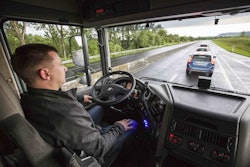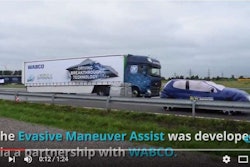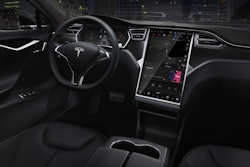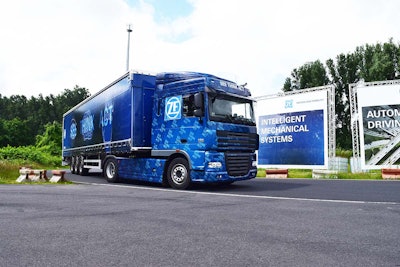 ZF’s Innovation Truck 2016
ZF’s Innovation Truck 2016Trucking’s future is digitized, electrified and connected.
That was the message relayed by researchers and executives this week in Aachen, Germany, at a major global press event held by ZF Friedrichshafen AG, a global supplier of axles, transmissions and steering components in both the automotive and trucking sectors.
|
But the Friedrichshafen, Germany-based company did more than just talk about those three trends converging in the world’s trucking industry: It pulled the curtain back on a concept tractor-trailer designed from the ground up with those concepts in mind. ZF built the Innovation Truck 2016 to show off next-gen truck technologies it says will be vital to the industry’s evolution in the coming two decades.
The futuristic combo will be on display at this fall’s IAA trucking trade show in Hannover, Germany, to give a worldwide audience a concrete view of the technologies tomorrow’s tractor-trailer will employ.
Those technologies include not only the Evasive Maneuver Assist (EMA) system ZF announced this week (and showed off in a track demo in Aachen), but also an advanced hybrid drivetrain that runs exclusively on electric power at speeds below 30 mph and a Level 3 autonomous system that lets the truck drive itself on the highway. The Highway Driver Assist automated driving system enables the truck to pilot itself in on-highway use by automatically keeping its lane, steering, accelerating and braking.
The Innovation Truck also puts to use an advanced automated backing system that allows drivers to exit the truck in docking situations and remotely back the vehicle to a dock. It also features a crawling mode for start and stop traffic made possible by ZF’s Traxon automated transmission.
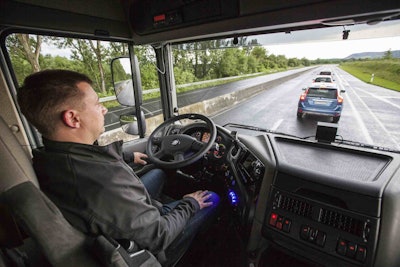 A demonstration of ZF’s Highway Driver Assist — an autonomous system that enables the truck to pilot itself in on-highway driving.
A demonstration of ZF’s Highway Driver Assist — an autonomous system that enables the truck to pilot itself in on-highway driving.The concept truck is a European model — a DAF XF — but the tech it’s meant to show off will be used in all markets, ZF says, and quicker than many may think. “Our focus is 2025,” says ZF’s CEO Sefan Sommer. “We have to rethink the architecture of automobiles to have new concepts and new technologies.”
Sommer says three major automotive “megatrends” are driving ZF’s research and development: safety, efficiency and automated driving.
The safety megatrend centers on systems like ZF’s EMA — that is, active safety systems meant to avoid crashes altogether — and passive systems that can at least minimize the consequences of accidents when they do occur.
The efficiency megatrend deals with driving down fuel consumption and lowering global emissions. Technologies stemming from the trend include alternative fuel development and vehicle electrification.
Lastly, the autonomous megatrend will bring sophisticated systems built around radar, laser scanning, cameras and other sensory systems to nearly all trucks and passenger cars, says ZF’s Peter Lake, member of the board. “Automated driving is real and it’s here to stay in the trucking industry,” he said. “We’re in a period of change like no other seen [in the automotive industry].”
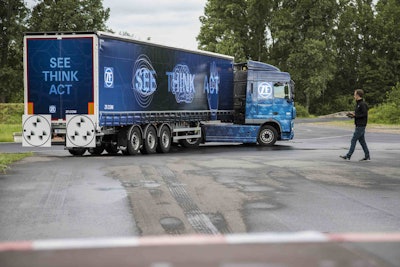 A demonstration of the Innovation Truck’s remote backing/docking system. Here, the driver is operating the truck via a tablet while standing outside of the vehicle.
A demonstration of the Innovation Truck’s remote backing/docking system. Here, the driver is operating the truck via a tablet while standing outside of the vehicle.Lake says vehicle automation will be one of the main drivers of vehicle-to-vehicle communication systems and vehicle-to-infrastructure communication systems. Likewise, the fast-approaching “Internet of Things” — that is, the ability of everyday items to become two-way senders and receivers of data via Internet connection — will be a catalyst for increased vehicle connectivity.
“The theme is more intelligence in mechanical systems,” Lake says. “Putting the brains in the brawn, if you like.” Lake says ZF is uniquely positioned to be a leader in the development of next-gen safety and automation systems. Its global automotive footprint lets the company spread research and development costs across multiple sectors, and then replicate new tech company-wide when the core engineering work is done in a specific sector, Lake said.
ZF uses the tagline “See, Think, Act” — displayed prominently on the Innovation Truck’s trailer — to define how its futuristic tech systems work. Vehicles of the future will use a bevy of sensory inputs (like the aforementioned cameras, radar and laser scanning) to “see” the road around them, says Sommer. They’ll use high-powered computers and algorithms to “think” and make determinations based on what they see. Then, trucks and cars of the future will use smart hardware and components to “act”; they’ll accelerate, decelerate and steer all on their own.
Smart hardware components are the bedrock for ZF’s seeing, thinking, acting concept. And it’s that smart hardware that’s the bedrock of the technologies on display in the Innovation Truck.
See video coverage of ZF’s Innovation Truck on CCJ next week.



